Jurassic World Full Body T Rex Drawing
This article refers to Tyrannosaurus in the Jurassic Park film canon. You may be looking for the novel canon.
- "Somewhere on this island is the greatest predator that ever lived."
- —Roland Tembo(src)
Tyrannosaurus rex , commonly known as T. rex , is a species of theropod dinosaur that lived during the Late Cretaceous Period, 68 to 66 million years ago. Arguably the most famous species of dinosaur, T. rex lived in what is now North America, alongside species such as Ankylosaurus, Edmontosaurus, Pachycephalosaurus, Alamosaurus, Nanotyrannus, and Triceratops. Tyrannosaurus was among many dinosaur species cloned by InGen and settled on the Costa Rican islands of Isla Sorna and Isla Nublar, for use as an attraction for Jurassic Park, and later, Jurassic World.
An apex predator capable of reaching thirteen meters in length, Tyrannosaurus was the largest species of Tyrannosaurid, and was intended to be the star attraction of John Hammond's vision for the original Jurassic Park.[1] [2] During the Isla Nublar Incident in 1993, a female T. rex escaped from her enclosure, and became wild on the island.[2] [3] Seven Tyrannosaurs existed on Isla Sorna, an island in the Muertes Archipelago originally used by InGen as a cloning facility for their dinosaurs. A family unit consisting of an adult male, an adult female and an infant were encountered during the Isla Sorna Incident in 1997, during which the male was captured and brought to San Diego, where it was intended to be used in the failed park, that Hammond had originally envisioned before acquiring Isla Nublar. The animal promptly escaped and wreaked havoc on the city, before being returned to Site B.[4] Three years later, another male Tyrannosaur was encountered on Isla Sorna, where it fought and was killed by a Spinosaurus.[5] Sometime in 2016, at least one Tyrannosaurus was involved in an incident with the kids of Camp Cretaceous in an unknown location, although currently it's unknown if this is a new individual or one seen in 1997.
The individual from the original park was eventually captured in 2002 and placed in captivity in Jurassic World on Nublar, residing in T. rex Kingdom. During the climactic events of the 2015 Isla Nublar Incident, it was released from captivity, and fought, and helped defeat, the genetically modified hybrid Indominus rex.[6] This same T. rex became wild once more, though became threatened three years later during the volcanic eruption of Mount Sibo.[7]
Contents
- 1 History
- 1.1 In the Past
- 1.2 Isla Nublar Incident & Aftermath (1993)
- 1.3 San Diego Incident (1997)
- 1.4 Isla Sorna Incident (2001)
- 1.5 The Evolution of Claire (2004)
- 1.6 Jurassic World (2005-2015)
- 1.7 Eruption of Mount Sibo (2018)
- 1.8 Attacking Humanity (2022)
- 2 Characteristics
- 2.1 Physical attributes
- 2.2 Behaviour
- 3 Behind the Scenes
- 3.1 Jurassic Park (1993)
- 3.1.1 Design
- 3.1.2 Portrayal
- 3.2 Vocalizations
- 3.3 The Lost World: Jurassic Park (1997)
- 3.3.1 Design
- 3.3.2 Portrayal
- 3.4 Vocalizations
- 3.5 Jurassic Park III (2001)
- 3.5.1 The Replacement
- 3.5.2 T. rex versus Spinosaurus
- 3.6 Jurassic World (2015) and Fallen Kingdom (2018)
- 3.7 Dominion (2022)
- 3.1 Jurassic Park (1993)
- 4 Trivia
- 4.1 Cultural Impact
- 4.2 Paleontology
- 5 Gallery
- 5.1 Images
- 5.2 Vocalizations
- 6 Appearances
- 6.1 See also
- 6.1.1 Novels
- 6.1.2 Games
- 6.1.3 Individuals
- 6.1 See also
- 7 Notes and references
- 8 Navigation
History
In the Past
A later flashback in the Cretaceous showed that a feathered Tyrannosaurus appeared in prehistoric times where it was clashed against a Giganotosaurus, but it was killed after the battle. A mosquito lands on and bites the dinosaur's right side of the snout, giving the future scientists of Jurassic Park the chance to create Rexy, the modern descendant of this very same T. rex.
Isla Nublar Incident & Aftermath (1993)
- "We have a T. rex!"
- —John Hammond, to Ellie Sattler and Alan Grant.(src)
Seven Tyrannosaurus rex were cloned by InGen scientists in their compound on Isla Sorna, circa 1990.[4] [5] [8] A female Tyrannosaurus was transported to Isla Nublar to star as the main attraction of Jurassic Park, inhabiting the Tyrannosaur Paddock.[2] The paddock was originally intended to be inhabited by an adult, and a juvenile Rex, though it is unknown if a juvenile was ever transported there.[9]
A Tyrannosaurus skeleton was also on display in Jurassic Park's Visitor Center along with the skeleton of an Alamosaurus.
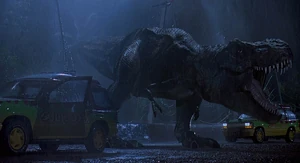
The Tyrannosaurus breaks out of its paddock during the Isla Nublar Incident.
Nublar's Tyrannosaurus was supposed to have been seen by InGen's endorsement team on their tour of Jurassic Park. However, despite attempts by Ray Arnold to lure her out of her paddock with a live goat, it did not originally reveal herself to the visitors.[2] When Dennis Nedry disabled most of Jurassic Park's security with a sophisticated virus, it was one of the dinosaurs that were able to roam the island freely. One of the embryos Nedry stole from the Cold Storage Room was Tyrannosaurus.[2] Upon eating the goat that was left for her, the Tyrannosaur escaped her exhibit and attacked the endorsement team, who were stranded near her paddock, eating Donald Gennaro. After pushing the tour vehicle of Lex and Tim Murphy off a cliff with Tim inside the vehicle, she attacked Dr. Ellie Sattler and Robert Muldoon who were searching for the survivors. After a short chase, she gave up, though.[2]
The next day, during Grant's, Tim's, and Lex's continued trek to the Visitor Center, they found themselves in the Gallimimus Enclosure, and witnessed a stampeding herd of Gallimimus. They ran alongside the dinosaurs momentarily before hiding behind a fallen log. The T. rex suddenly crashed through the nearby bushes next to the stampede stumbling a Gallimimus. This Gallimimus tried to run away, but was too slow to react, and the Tyrannosaur lunged at it, catching the dinosaur in her jaws before proceeding to shake the Gallimimus to death. Dr. Grant, Lex, and Tim watched in amazement as the T. rex started to feast on the carcass. Lex begged Dr. Grant for them to go, to which Grant obliged. However, Tim continued to stare in fascination and so had to be forcibly taken away by Dr. Grant.[2] She never fully consumed this Gallimimus and its remains were still present in the location where it had died by October 6, 2002, over a decade later. Her roar was later heard from afar when Dr. Grant and the kids were trying to get through the deactivated electric fence, prompting them to climb over.[10]
The T. rex was seen later that day when she had come through the hole in the wall and grabbed a Raptor from mid-air just as it was to pounce on the humans and crushed it in her jaws. Using the distraction that she provided, the humans fled. Meanwhile, another raptor that pursued the group through the Visitors Center pounced on the larger theropod. She snapped at her but could not reach her as the raptor continued to rip and tear madly. Rolling her head, the Raptor fell into the T. rex's mouth where she was killed and then thrown against the Tyrannosaurus skeleton and the T. rex let out a mighty bellow in triumph as the "When Dinosaurs Ruled the Earth" sign fell to the ground.[2]
In the aftermath of the incident, the T. rex went wild and lived on Isla Nublar for about a decade,[8] [11] probably surviving off any of the herbivorous dinosaurs that managed to survive the incident.
San Diego Incident (1997)
- "I'm trying to change 100 years of entrenched dogma. Dinosaurs were characterized very early on as vicious lizards. There's a great deal of resistance to the idea of them as nurturing parents. Robert Burke said that the T. rex was a rogue, who would abandon its young at the earliest opportunity... I know can prove otherwise."
- —Dr. Sarah Harding, to Ian Malcolm during the Isla Sorna Incident (src)
The Tyrannosaurus rex on Isla Sorna became wild after Hurricane Clarissa struck the island, soon after the abandonment of Isla Nublar. They were freed by either breaking out of their cages or by the workers on the island before they fled. As with the T. rex on Nublar, to counter the Lysine contingency, T. rex and the other carnivorous dinosaurs ate herbivores who in turn ate lysine-rich plants as one of their sources of lysine.[4] Tyrannosaurus rex had varying levels of success on Isla Sorna. In the island's south, they were the apex predator of the region, but in the north they were undermined by Spinosaurus.[4] [5]
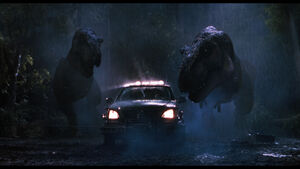
The male and female Tyrannosaurs moments before killing Eddie Carr.
A Tyrannosaur family was involved in both the Isla Sorna Incident of 1997 and the following San Diego Incident. Their involvement began when the son was taken from the parents by InGen Hunters Roland Tembo and his hunting partner Ajay Sidhu, who intended to use the infant as bait to lure the father, whom Tembo, a seasoned hunter, aspired to kill.[4] While the infant called for his parents to rescue, Peter Ludlow accidentally broke his leg while drunk, when he was startled by the sound of an animal moving through the undergrowth.[12]
After the Gatherers freed the dinosaurs captured by the InGen Hunters, Nick Van Owen discovered the infant T. rex. He decided to take him back to his team's mobile laboratory, where he and Dr. Sarah Harding mended the juvenile's leg. However, his parents arrived after first aid was applied, and began to corner the laboratory. Dr. Harding realized that the two Tyrannosaurs weren't exhibiting hunting behavior so she convinced her fellow Gatherers to hand the young T. rex to his parents.[4] Upon returning the infant to safety, the adult Tyrannosaurs returned to the mobile lab and began to push it over a cliff. However, Eddie Carr saved his fellow Gatherers from falling with the RV, but was promptly killed by the predators. Attracted by the smell of blood on Dr. Harding's shirt, the Tyrannosaurs parents traveled to the new camp of the Gatherers and the Hunters, and attacked the camp.[4]
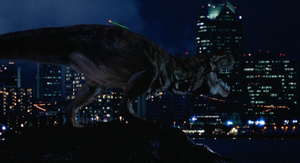
The Buck, moments after being freed in San Diego.
While the Hunters fled, the female Tyrannosaur followed, killing many of them in the process. As the Tyrannosaur Buck continued his search, he was tranquilized by Roland Tembo (due to the fact that Nick Van Owen stole the bullets intended to hunt the dinosaur). After the female Tyrannosaur's attack, Peter Ludlow ordered the remaining InGen Hunters to secure the Tyrannosaur Buck and recapture the juvenile T. rex for Jurassic Park: San Diego. But his plan went astray when the Tyrannosaur Buck escaped confinement upon reaching San Diego, California and went rampaging throughout the city, killing several civilians.[4]
To stop the chaos, gatherers Sarah Harding and Ian Malcolm broke into Jurassic Park: San Diego to steal the baby Tyrannosaur so they use him to lure his father back into the docks. The plan worked, but when Peter Ludlow tried to recapture the juvenile, he was crippled by the Tyrannosaur buck and finished off by the infant. The Tyrannosaur Buck's rampage ended when Dr. Harding tranquilized him before the San Diego police could shoot him. Both Tyrannosaurus father and son were reunited once more with the female when they were transported back to Isla Sorna.[4]
Isla Sorna Incident (2001)
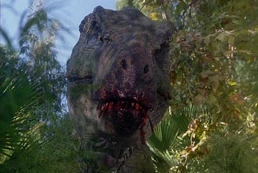
A T. rex was found by Dr. Alan Grant and a group of people during a rescue mission to Isla Sorna in 2001.
As a result of the San Diego Incident, Isla Sorna, and presumably Isla Nublar, were designated as restricted areas. In 2001, Eric Kirby, a teenage boy marooned on the island from illegal sight-seeing, collected T. rex urine that he used to deter small carnivorous dinosaurs such as Compsognathus though he also learned that it attracted the island's intensely territorial Spinosaurus.[5] Weeks later, a smaller male T. rex encountered a group of people led by Dr. Alan Grant, who travelled to Isla Sorna to rescue Kirby, while eating a Parasaurolophus.[13] [5]
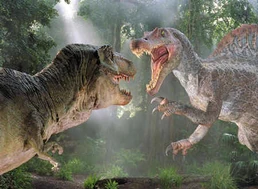
The male T. rex faces off against the Spinosaurus.
Grant tried to avoid the T. rex by standing still, but the Tyrannosaur noticed them and gave chase, bringing him into contact with the Spinosaurus. The two theropods sized each other up and began to fight. The Tyrannosaurus was the first to attack in the dual, biting down on the neck of the Spinosaurus and bringing it down to the forest floor. The Spinosaurus regained balance, however, and began to snap at his flanks. After the Spinosaurus swiped at him, the T. rex rammed his opponent head first, resulting in the Spinosaur biting down on the T. rex's neck. As the Rex roared in agony, the Spinosaur, with support from its arms, proceeded to snap its neck. The T. rex's body collapsed to the ground, nearly crushing Dr. Grant while escaping. The Spinosaurus then claimed the carcass of its fallen foe triumphantly.[5]
The Evolution of Claire (2004)
- "Well, if there is a queen of dinosaurs, it's probably her."
- —Bertie, describing the T. rex to Claire(src)
The original T. rex from Jurassic Park, dubbed "Rexy," was contained in a paddock near Main Street for Jurassic World. Her paddock was described as being densely packed with jungle growth, with a viewing booth on a transparent wall that overlooked the enclosure. She was normally fed live meat, typically goats as that was her preference, but once a month she was given meat mixed with amino acids and other nutrients to keep her healthy and strong; a flare was used for visual aid since she associated it with food. Her behavior was often withdrawn, which would be mistaken as shyness, but it was explained that she "decided [humans] need to earn her respect." She was considered wise, calculating, and curious.
Jurassic World (2005-2015)
- "We need more teeth!"
- —Gray Mitchell, inspiring Claire Dearing to release the T. rex on the Indominus (src)
On April 19, 2002, during the planning stages for the construction of a new park on Isla Nublar known as Jurassic World, the original female Tyrannosaurus bred for the original park was captured by an InGen security team led by Vic Hoskins.[14] The Tyrannosaur was placed in the T. rex Kingdom attraction, where she was intended to serve as one of Jurassic World's most popular animals once the park was open in 2005.[15] Though it was the only Tyrannosaurus known to live in the park, there was a Cold Storage room for Tyrannosaurus present in the Hammond Creation Lab in the mid-2010s.[16]
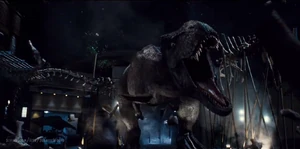
The T.rex smashes through the Spinosaurus skeleton prior to her fight with the Indominus rex.
The base genome of the Indominus rex, a genetically engineered hybrid that caused the second incident on Isla Nublar was Tyrannosaur.[6] During the hybrid's rampage across the island, the T. rex remained in her enclosure.
The wreck of the Tyrannosaurus skeleton remained in the ruins of Jurassic Park's visitor center since the incident 12 years ago. Zach Mitchell used a rib from the skeleton along with a piece of the "When Dinosaurs Ruled the Earth" banner to make a torch when he and his brother Gray explored the place. The skull was later crushed under the weight of the Indominus rex's hand when it chased Owen Grady and Claire Dearing in the same area before being pursued by the JW001.
The T.rex was eventually released by Lowery Cruthers under the orders of Claire, who lured it to fight against the Indominus. Smashing through the skeleton of a Spinosaurus, it bellowed threateningly at the Indominus, and the two began a vicious fight.
Though the Indominus overpowered the T. rex with her strong forearms, the Velociraptor Blue attacked the hybrid, allowing the veteran Tyrannosaur to overpower the Indominus, pushing it to the side of the Jurassic World Lagoon, where the park's Mosasaurus leaped from the water, and dragged the hybrid into the depths. Briefly looking at Blue, it turned away and slowly made her way into the jungle.[6] Free on the island once more, it made her way to the top of the Jurassic World's control center, and bellowed triumphantly.[6]
Eruption of Mount Sibo (2018)
- "The T. rex would be dead by now, right?"
- —Franklin Webb.(src)
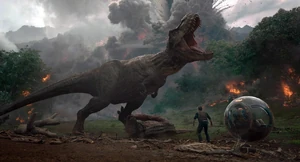
The T. rex subdues a Carnotaurus during the eruption of Mount Sibo.
After the Indominus rampage throughout Jurassic World, Isla Nublar was once again abandoned to the dinosaurs, left to their own devices without human interference.
A few months after Jurassic World fell, she attacked a group of mercenaries. One man is left on the ground and their helicopter lets down a rope ladder. They escape the Tyrannosaurus but the man on the rope ladder is swallowed by the Mosasaurus after it jumps into the air, and the Mosasaurus escapes from its pen.[7]
Three years after the abandonment of the park, and two years after she messed with the mercenaries, Mount Sibo, the volcano which provided geothermal power to the original park, began to erupt, prompting Claire Dearing to organize a mission to rescue the dinosaurs from the doomed island.[7]
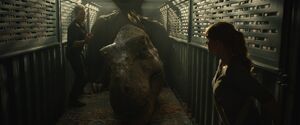
Tyrannosaur sleeping in transport truck.
At some point during the mission, in the midst of a stampede away from the eruption, the original T. rex bred for Jurassic Park attacked and fatally subdued a Carnotaurus, inadvertently saving Owen, Claire, and Franklin Webb.[7]
The Tyrannosaur was later captured and, in a desperate attempt to save Blue, Claire and Owen had to get some of her blood. They found the Tyrannosaur and successfully got her blood but were locked in by some guards as the T. rex woke up. As the agitated animal began to freak out and thrash violently, Claire escaped through the top and opens the main doors of the cage; Owen narrowly escapes the T. rex's snapping jaws before she can bite him in half.[7]
She was put into a cage underneath Lockwood Manor and, after nearly suffocating from a hydrogen cyanide leak, she was saved by being released by Maisie Lockwood into America. But before she leaves, the T. rex suddenly appears and snatches Eli Mills in her jaws, brutally shredding him before tearing him in half with a Carnotaurus, and ultimately devouring Mills, the T. rex then knocked over the Carnotaurus with her head and the Carnotaurus got up and ran off. After snapping at the Carnotaurus heels, the T. rex roared and walked away, crushing the I. rex fragment in the process and ensuring that no carnivorous hybrid could ever wreak havoc upon the world again.[7]
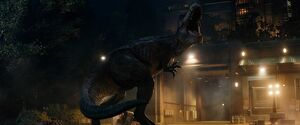
Tyrannosaurus roaring after killing Mills.
After she escaped, the T. rex broke into a nearby zoo and roared at an African lion, who stood his ground by angrily roaring back at her.[7] As the T. rex begins to break into the zoo roaring at the male lion, the zoo's staff attempted to capture her. The T.rex bites tugs at the rope carrying the cage by a helicopter before managing to escape back into the forest.

The T. rex eating the remains of Eli Mills with the Carnotaurus
Attacking Humanity (2022)
Four years later, T-rex then attacks humans and cars in the theater, then she roars loudly, until helicopter, chasing Rexy to the forest.
More to be added.
Characteristics
Physical attributes
Tyrannosaurus cloned by InGen had fully scaled skin as juveniles and as adults,[4] when it is considered by scientists that Tyrannosaurus was feathered at least some parts of its body. The presence of feathers was seen in the naturally born individuals seen in the sequence taking place in the Cretaceous Period, where an adult Tyrannosaurus sports a short cape and mane of filamentous feathers across its back, neck, and shoulders. Its skin was thick, being able to offer some resistance to the razor-sharp toe claws of a Velociraptor,[2] and the sharp claws of the hybrid Indominus rex that were able to debilitate a full-grown Apatosaurus as well as the strong bite of the Indominus, which was able to crack the bulletproof glass of a Gyrosphere.[6] However, many of the adult Tyrannosaurs encountered by humans would bear at least one scar that would be found on their head or neck. Two adult males had a single scar on the side of their face.[4] [5] The individual from Isla Nublar had several scars on her neck from a cloned Velociraptor that pounced on her.[6]
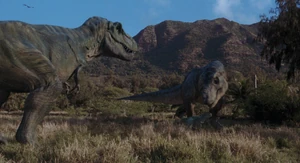
A Tyrannosaur family unit on Isla Sorna in 1997.
Sexual dimorphism was present in the recreated Tyrannosaurus, such as the males having a throat wattle and much more prominent brows.[17] The males also had deeper vocalizations than the females[4] [5], though the female T. rex of Isla Nublar also had deepened vocalizations when she got older.[6] Every adult Tyrannosaur encountered each had their own unique skin color and pattern. Males tended to have a green skin color and females tended to have a brown color while the juvenile known as Junior was a mix of the two aforementioned colors.[18]
According to founder and former CEO of InGen John Hammond, the cloned T. rex could run at speeds of 32 mph.[2] The clones seemed to have had an accelerated growth cycle as the Tyrannosaurus rex of Isla Nublar was the size of a 28-year-old when she was only five[15] [11] and the only juvenile observed, Junior, was the size of a two-year-old tyrannosaurid yet was still highly dependent on his parents.[4]
In 2018, the Dinosaur Protection Group website uploaded an informative graphic for the "average" InGen Tyrannosaurus, with a length of 12 meters (39.4 feet, though this is commonly rounded up to a simple 40 feet in the franchise) and 7 tons (14,000 pounds).[19] [20]
Behaviour
Unlike their prehistoric forebears, Tyrannosaurs bred by InGen were thought to hunt prey by seeing movement, likely considering stationary objects to be less of a threat.[2] [4] [5] [6] [21] This theory would be called into question during an incident on Isla Nublar where social media influencer Brooklynn tricked a T. rex into attacking a static cardboard cutout bearing her likeness. [22] From what has been observed of wild Tyrannosaurs, they were solitary animals, though a breeding pair on Isla Sorna roamed in the island in a pack.[5]
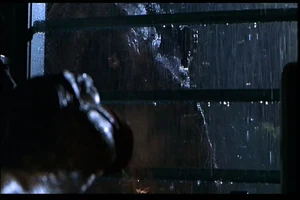
Both male and female Tyrannosaurs were fiercely protective of their infants.
Though Robert Burke postulated otherwise, Tyrannosaurs were great parents, with Dr. Sarah Harding correctly theorising that T. rex cared for their young.[4] The offspring would stay in a nest while the parents would provide food for them for about two weeks until the juveniles learned to hunt on their own. While it's unknown for sure how many eggs and young they had in a litter total (though only one is shown in the first sequel), if a Tyrannosaurus baby went missing, its parents would search for it by hearing its cries or by smelling its blood. Even if they had retrieved their juvenile, Tyrannosaur parents smelled their offspring's blood on a potential threat, they would confront it.[4]
Tyrannosaurs reflected a high level of intelligence in several instances. The individual of Isla Nublar, in particular, has shown a good deal of intelligence during both the Isla Nublar incidents in both 1993 and 2015. In the former, she tested the electrical fences after the power outage, seemingly aware of the lack of power before attempting to escape.[2] During the incident in 2015, it showed enough intelligence not to attack Blue during and after their fight with the Indominus, aware of the key role the Velociraptor played in distracting the hybrid as it attempted to kill her.[6] Both the male and female Tyrannosaurus during the Isla Sorna Incident in 1997 also showed a high degree of intelligence, seen in their efforts to protect their infant from the humans, even going so far as to push a trailer over a cliff and hunt in a familial pack.[4]
Behind the Scenes
Jurassic Park (1993)
Design
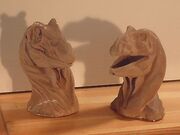
Early design concept by Tim Lawrence
Early design work for the Tyrannosaurus entertained ideas not present in the final film. One early concept Spielberg considered was to give the dinosaurs frog-like features to show their origin as genetic amalgamations. Artist Tim Lawrence created an early head sculpt with the basis coming from toads. This was never meant to be the final design, as certain features like teeth were omitted, but just a basis to test the ideas.
Mark "Crash" McCreery created the design of the T. rex that was used in the film. McCreery was working on Terminator 2: Judgment Day when the late Stan Winston moved him from that project to create sketches of the T. rex to generate interest in the film for Universal Studios.[23] His first drawing was the T. rex running against a plain white background as a motion study. His second was of the T. rex in a jungle setting lifting its left leg high in an attack stance reminiscent of a bird of prey.[24] McCreery created the designs without a reference to go by, creating the drawings with what he remembered in his mind of then-current information and new paleontological findings. After these sketches were done, Winston showed Steven Spielberg what McCreery had created and Spielberg gave his suggestions for the design of the animal. He felt that the design depicted in McCreery's drawings should have longer legs to hold the weight of it and that the feet were too small and bird-like. Spielberg also felt that the forearms looked weak.[23]
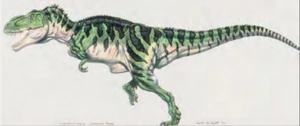
Character study by Mark Hallett from 1990.
Several paleoartists were contacted in 1990, notably to design the T. rex. Among those consulted were Mark Hallett, Gregory S. Paul, and John Gurche. As his first assignment from production designer Rick Carter, Mark Hallet created concept art of the T. rex breakout. Afterward, Hallett created concept art of the Tyrannosaur's attack on the explorers and then storyboards of the Tyrannosaur's attack from the driver's side view of one of the tour vehicles. Finally, he created a character study of the T. rex.[25] Concept art of scenes featured of the T. rex by Craig Mullins,[26] David Negron,[27] John Bell,[28] and Tom Cranham,[29] resemble Hallet's design. Paleontologist Gregory S. Paul created skeletal and muscle studies of the Tyrannosaurus rex to be used as the base form of the dinosaur.[30] [31] Paleoartist John Gurche also did concept art of the T. rex, these concepts being its anatomy and reconstructions that were accurate for its time.[32] Paleontologist Dr. Robert Bakker sent the filmmakers diagrams of Tyrannosaurus teeth, but according to Bakker "the powers that be didn't like the real tooth shape" and used a different, inaccurate design for its teeth.[33] The eyes of the T. rex were kept party by director Steven Spielberg because he felt it looked better when she was running toward the camera.[34]
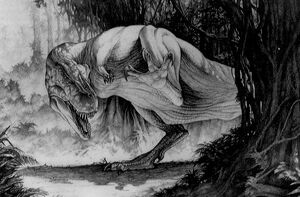
The second concept art made of Tyrannosaurus by Mark "Crash" McCreery.
Winston and McCreery would spend months redesigning the T. rex multiple times until a finalized design was reached.[23] When sculpting the 1/5 scale maquettes, Stan Winston and Mike Trcic spent time focusing on the design of the T-rex's head, with the maquettes going through over thirteen different head designs as according to Paul Mejias, "[The dinosaurs] had to be perfect."[35] Trcic created several anatomically accurate T. rex head sculpts as a potential design, but this would go unused in favor of a broader head and exposed front teeth.[36] According to Gregory S. Paul, Trcic also used one of Paul's T. rex skeletals when designing the T. rex,[37] but director Steven Spielberg and Stan Winston ordered the dinosaurs to receive alternations from the current scientific knowledge of the dinosaurs Paul created skeletals for to copyright their designs, even though Trcic wanted to strictly use Gregory S. Paul's diagrams.[38] [30] [37] However, Trcic has said that after many arguments with Winston over the design of the T. rex, the T. rex design was "60% where [he] wanted it to be." McCreery then created another design of the T. rex based on the maquette.[39]
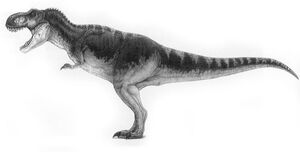
Concept art of a design of the Tyrannosaurus by McCreery from 1991.
Early concepts of the T. rex depicted her as having a green coloration with black striping.[27] [29] [40] The final coloration of the T. rex chosen for the first film was a dark brown color. McCreery explained that the reasoning behind this was because an animal as large as T. rex would not need camouflage and that the team feared that too strong of coloration might make it look fake.[41] A green coloration would later be used for the males in The Lost World: Jurassic Park and Jurassic Park III. The design that "Crash" McCreery first created would later be colored and used in promotional material for Jurassic Park and its sequel The Lost World: Jurassic Park.
Portrayal
- Stop-motion to CGI
Originally, most of the wide shots of the dinosaurs were to be portrayed by go motion animation created by Phil Tippett.[42] With consultation from Mark Hallett,[43] Stefan Dechant had created digital animatics featuring a computer-generated T. rex, but these were replaced by the go motion animatics created by Tippett Studio.[44] An animatic was even created of the breakout sequence featuring the go motion T. rex. Tippit and his team sent Spielberg animation tests of Tyrannosaurus and Velociraptor. Though a motion blur was added to make the stop motion dinosaurs more realistic, Spielberg felt that the movements of the dinosaurs were still jerky. Dennis Muren then suggested to Spielberg that Industrial Light and Magic create computer-generated full-sized dinosaurs. Interested, Spielberg requested a test be made featuring CGI dinosaurs.[42]
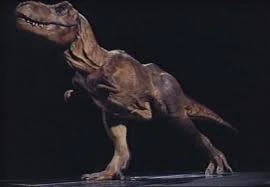
The go motion Tyrannosaurus.
After ILM created a herd of Gallimimus skeletons running,[42] Steve 'Spaz' Williams with support and assistance from Mark AZ Dippe, his friend and confidant, created a running Tyrannosaurus skeleton during off-hours and in-between assignments at ILM. The reference he used for the skeleton came from page 341 of Gregory S. Paul's 1988 book Predatory Dinosaurs of the World.[45] Spielberg was not fully convinced to use CGI for the dinosaurs until ILM made more tests featuring a fully fleshed T. rex and said T. rex chasing a herd of fully fleshed Gallimimus.[42] This skin was rendered by Stefan Fangmeier.[46] Though the dinosaurs were to be now CGI in the film, the stop motion animatics and tests would be used as a reference for the animatronic dinosaurs.[47]
- Animatronics
A full-sized Tyrannosaurus animatronic was created by Stan Winston Studio for the filming of the dinosaur's breakout. Taking two years to make, the animatronic was the first animatronic to be mounted on a motion simulator to achieve gross body movements and at the time was the largest animatronic the studio ever produced[48] only being surpassed by the Spinosaurus animatronic created for Jurassic Park III.[49] Powered primarily by hydraulics,[50] a 1/5 scale telemetry device shaped like the dinosaur was used to provide the movements of the full-sized animatronic[47] with the eyes being radio controlled.[51] Another animatronic was also used for shots of its feet that was an underbelly on a rolling platform with hydraulic legs and tail.[51] [52] Another prop was a separate head with extra detailing and added mechanics used for close-up photography.[51]
There had been plans to create a full-sized sleeping T. rex that was later conceived as a miniature when Stan Winston proposed to the studio that the money that was to be used for this animatronic be used to create the full-sized Tyrannosaurus instead until the sleeping T. rex was scrapped altogether.[53] Concept art was even created by "Crash" McCreery of this cut prop.[54] Stan Winston Studio also considered using a 1/5 scale rod puppet before the full-sized animatronic was conceived.[53] This concept would later be put to life for the sequel Jurassic Park III, but only as a test.[55] Speilberg had also originally wanted the animatronic Tyrannosaurus to be a freestanding and that was able to walk until it was discovered that it was not possible and he realized how impractical it would be.[56]
The animatronics were filmed on set at Warner Brothers Studio Stage 16.[57] For the filming of the attack sequence, the animatronic with legs [52] [47] and the insert head were used. The insert head, in particular, was manipulated by a highly poseable hydraulic-powered crane as well as man-power.[58]
There were troubles while filming the scene as both the animatronics began to shiver due to their latex skin absorbing the rain,[47] requiring the crew to dry the animatronics down after every shot.[59] Filming also received a major setback when the head-turn cylinder of the full-sized animatronic broke, though this was quickly repaired.[60] Overall, shooting of the scene was finished four days ahead of schedule.[61]
In the original endings for Jurassic Park, one raptor was to be crushed by one of the falling skeletons while the other would either be moved and crushed to the jaws of the T. rex skeleton by Dr. Grant using a crane or by Hammond shooting the raptor.[62] [63] [64] Another ending would have also featured Hammond coming killing the first raptor with a bazooka while Dr. Grant used a crane to kill the remaining raptor-like one of the other ending.[65]The T. rex was even scripted to die like her novel counterpart at one point.[66] These endings and her death were scrapped from the film because Spielberg believed the T. rex to be the star of the film alongside the smaller Velociraptor.[63]
Phil Tippit worked with ILM in post-production to create the dinosaur input device or DID for short; an armature like that seen in go motion models that could be manipulated by Tippit and his team of stop-motion animators.[67] Out of the four DIDs created, two were for T. rex while other two were for the raptors.[68] The T. rex DIDs was only used for the road attack sequence while ILM created the rest of the shots featuring T. rex as Tippitt's team and ILM were originally going to work together until it was decided that both would be split into two teams.[69] The digital model for the T. rex received several changes from Spielberg that differed from the animatronic, these changes being a different arm length, larger and stockier feet, and a more streamlined jaw as well as adjustments to her eyes.[34] Years later, ILM would modify the T. rex model for lip-sync tests for the 1996 film Dragonheart.[70]
Vocalizations
The female roars were created from crocodiles, lions, alligators, dog, penguin, tiger, and elephant layered together.[71] [47] Whale blowholes were also used looped to create the sound of the dinosaur breathing.[71] The sound of the T. rex as it kills the Gallimimus was simply Rydstrom's dog, a Jack Russell Terrier named "Buster",[72] playing with a rope toy.[42] The footsteps of the T. rex were of redwood trees being cut down and falling to the ground.[47] The iconic high-frequency "scream" originates from a baby elephant that Gary Rydstrom and his team recorded. It was only recorded once creating this sound and the team tried to get the elephant to create the sound again, but it refused to do so. Because of this, Rydstrom used the same elephant sound for each take.[73] This elephant sound was used for mid-range frequencies with an alligator's growl and tiger's roar added.[71]
The Lost World: Jurassic Park (1997)
Design
For the The Lost World: Jurassic Park, a female, male, and juvenile Tyrannosaurus were set to appear in the film. In the digital storyboards by Stefan Dechant the male was depicted as either yellow and gray or as the same color as the female.[74] John Rosengrant later devised the green color scheme for the male.[75] One such concept by Rosengrant was a colored version of the 1991 T. rex concept art for the first film.[76] Another color scheme applied to this same concept art would be widely used in promotional material for the film. Even though the Buck was given a different skin color to differentiate it from the female, Stan Winston Studio was concerned that this would be difficult to see in low-light conditions. So Shane Mahan began to manipulate images of the T. rex from the first film, creating a series of eight head designs that he sent to Speilberg. The design chosen by Speilberg featured larger brows, a scarred face, and a neck wattle.[17]
Joey Orosco created the concept art for the juvenile.[77] The juvenile went through many changes in his color scheme, such as one of his maquettes depicting him as brown,[78] another maquette depicting him as bright green,[79] and one paint scheme of his animatronic depicting him as a duller green.[80] However, evidence in the film and promotional photos of the animatronic suggest that Junior is actually a mix of brown and green.[81] The female also received a new skin color as well, her skin being lighter than the previous female that appeared in the first film.[18] However, promotional material depicted her as a darker brown and sometimes with a bluish tent to her head.
Portrayal
- Animatronics
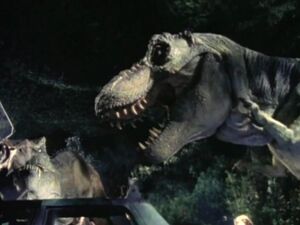
The two animatronic adults created for The Lost World: Jurassic Park.
For close-up shots in the film, two animatronics were used primarily to depict the tyrannosaur parents using the armatures of the full-body animatronic and insert-head of the first T. rex, the female in particularly using the insert-head armature. Unlike the first full-sized T. rex animatronic, the animatronics for the parents was from head to mid-torso with arms and were mounted on rail powered dolly carts.[82] This was done because Stan Winston Studio discovered there no need to make a full-sized animatronic like in Jurassic Park as the audience only the head and half the body could be seen. Furthermore, the carts provided more mobility and freedom when compared to the motion platform.[83] The most notable usages of the animatronics were when the parents approach the trailer and when they attack Eddie Carr.[84] Two animatronics were used to portray the juvenile. One was a mixture of hydraulics and cables used when he was laying on his side while the other was remote controlled and used when someone was carrying him.[84]
- From Pteranodons to San Diego
In one of the original endings for The Lost World: Jurassic Park, Pteranodon or Geosternbergia (then classified as a species of Pteranodon) were to attack the rescue helicopter at the end of the film.[85] While at his vacation home in the Hamptons for the Fourth of July, director Steven Spielberg suddenly saw an image in his mind of a boy looking out of his bedroom to see a T. rex drinking from the family swimming pool. Prompted by the image he saw, Spielberg changed the ending to what is seen in the completed film[86] and included the image he saw as the scene where the Buck approaches the house of young Benjamin and his family. In one concept of the T. rex being transported, it appears the mother was to be captured instead of the father as this T. rex is brown instead of green.[87]
Vocalizations
For the male, pigs and "weird Costa Rican mammals", mammals that Gary Rydstrom and his team recorded but never knew what their identities were, had a similar screech like the baby elephant used for the females and were used in place of the latter. The juvenile's vocalizations were of a baby camel crying for its mother.[85] The original T. rex roars were also reused for the female.
Jurassic Park III (2001)
The Replacement
In early logo designs for the film, Tyrannosaurus was to be featured like in the previous two films. Many of the logos had the same T. rex design used in the logos for the previous films, but there were different designs exhibited in the preliminary logos such as the T. rex with a more widened mouth,[88] the T. rex more upright and looking straight ahead,[89] and a full skeleton of T. rex roaring.[90] For Jurassic Park III, the filmmakers wanted to have another dinosaur to replace Tyrannosaurus from the previous two films[91] and searched through many candidates in the process.[92] Eventually Spinosaurus was chosen after Paleontologist Jack Horner suggested Spinosaurus to the filmmakers as a replacement[93] and from the discovery of a Spinosaur skull during the pre-production of the film.[49]
During early development of the film, Stan Winston Studio created a 1/5 scale rod-puppet T. rex. They filmed this rod-puppet in forced perspective to create several tests to see if they could prove a concept that would work.[55] This rod-puppet would ultimately go unused in the film.
T. rex versus Spinosaurus
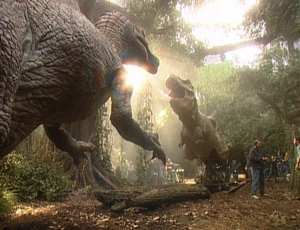
The Spinosaurus and Tyrannosaurus animatronics on set.
Director Joe Johnston created the famous Spino vs T. rex as an homage to Ray Harryhausen's go motion dinosaurs and wanted to recreate a modern version of those fights.[94] In one draft of the script the carcass the Tyrannosaurus was eating was a sauropod[95] when the actual prop used in the film is the Parasaurolophus carcass used in The Lost World: Jurassic Park repainted[96] and the carcass itself is left unidentified in the film.
For the battle, the animatronic of the Buck was refurbished.[97] Due to how powerful the mechanical Spinosaur was, the Spino destroyed the Tyrannosaurus with one final blow that broke its neck which in turn caused its head to collapse, releasing hydraulic fluid that John Rosengrant described as being "almost like blood spewing". Rosengrant further described the destruction of the animatronic as "[A] really sad ending to a long night of shooting".[49] Over 20 seconds of footage of the fight, particularly of the animatronics, was cut from the film.[98] Despite this, a shot of the animatronic fight where the Spinosaur slaps the Tyrannosaur was still present in the theatrical trailer.[99] For the CG T. rex, the model of the Buck from the previous film was reused as a basic framework, but when it was all finished, it was essentially a new model according to Tim McLaughlin.[100] New geometry was created for its surfaces so that it would work better in ILM's simulations. New animation controls were added as well that were up to date at the time the computer graphics were created for the film and the model's UV Maps were reworked, though originally the ones from The Lost World were to be used.[101]
Jurassic World (2015) and Fallen Kingdom (2018)
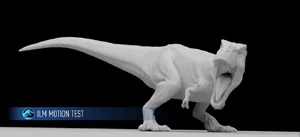
The Jurassic World CG model.
Jurassic World saw the return of the T. rex that appeared in Jurassic Park. Director Colin Trevorrow described the film "This is [the Tyrannosaur's] Unforgiven."[102] The T. rex model was created by Steve Jubinville and the director aimed to make the model look as close as possible to its design in the first film.[103] The Jurassic World Tyrannosaurus was made to look older by giving her the scars she received from the end of Jurassic Park as well as tightened skin. The T. rex was primarily portrayed with performance capture technology rather than life-sized animatronics.[102]
In Jurassic World: Fallen Kingdom, the Tyrannosaurus was recreated through a mixture of traditional animatronics and CGI.[7]
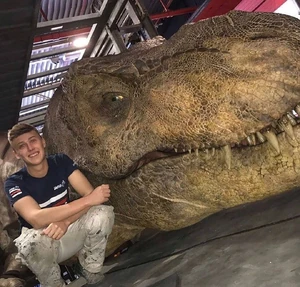
T. rex animatronics on set for Jurassic World: Fallen Kingdom
Dominion (2022)
Trivia
Cultural Impact
In popular culture, Tyrannosaurus has an iconic status shared by few other species, helped in no small part by the prominent role of the T. rex in all five films in the Jurassic Park franchise. The design of the Jurassic Park franchise's Tyrannosaurus is a notably popular way to depict Tyrannosaurus in media.[104]
Mike Trcic expressed disappointment with the popularity of this design in an interview with Shannon Shea (who worked with Trcic on Jurassic Park). In the interview, he said regarding how popular the design had become, "Whenever I search Google images for a Tyrannosaurus Rex [sic], most of the art I see is based on the original JP Rex. It's a shame that people just accept that somehow it IS what a T-Rex [sic] looked like. It's limiting because unless someone can travel back 65 million years, how can anyone be completely sure?"[105]
The vocalizations that were created by Gary Rydstrom are also a popularly used sound effect. Jurassic World sound designer Al Nelson said regarding how famous its roars were in the films: "The T. rex is one of the most iconic sounds in all of film history. Every sound designer knows it. Almost any kid knows it. When you hear it you're like 'That's the T. rex!'"[106]
Paleontology
Section for real-life paleontology
Like other tyrannosaurids, Tyrannosaurus had very short arms with only two fingers. Despite the limbs' size, each were able to bench-press about 400 pounds. Although these were probably nearly useless while hunting, its jaws were not: Tyrannosaurus has an enormous skull armed with teeth the size of bananas. Unlike the teeth of most theropods, the teeth of tyrannosaurids are very thick and capable of crushing bones and with a bite force of a minimum of 4 tons of force and probably more, crushing bone, ripping flesh, and bursting blood vessels of the victim. The skull and neck bones show that T. rex had the largest neck muscles of any meat-eating dinosaur. It probably used its strong neck to twist and pull off big chunks of meat that it grasped with its jaws while supporting the huge head. Tyrannosaurus could bite with extremely strong force - one fossilized skeleton shows that it crushed and swallowed the bones of a smaller plant-eating dinosaur while another shows a Tyrannosaurus coprolite with the crushed frill of a Triceratops. Additionally, in Jurassic World: Alive, the Generation 2 Tyrannosaurus is referred to as Tyrannosaurus magnus, which scientists have considered a separate genus, Zhuchengtyrannus.[1]
Gallery
Images
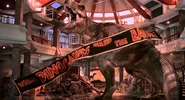
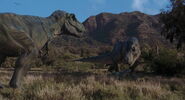
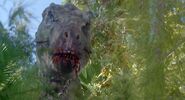




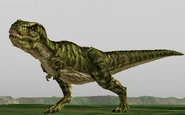
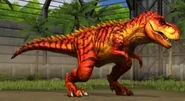

Second Generation of Tyrannosaurus in Jurassic World: The Game
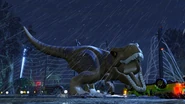
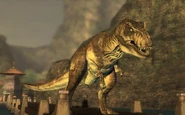
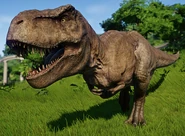
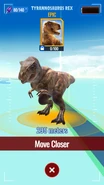
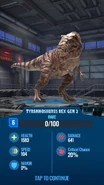
Second generation of Tyrannosaurus in Jurassic World: Alive.
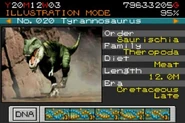
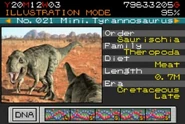
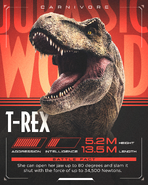
Tyrannosaurus card from "Jurassic Battles."
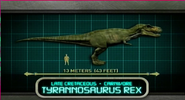
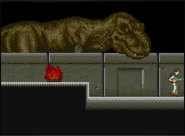
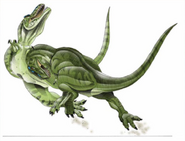
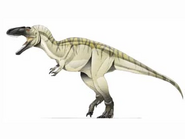
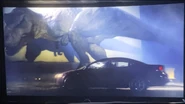
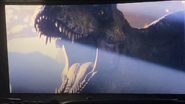


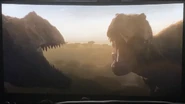
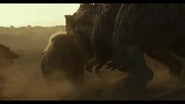
Vocalizations
Appearances
- Jurassic Park (First appearance)
- The Lost World: Jurassic Park
- Jurassic Park III
- Jurassic Park: The Game
- Jurassic World
- Jurassic World: Camp Cretaceous
- Jurassic World: Fallen Kingdom
See also
Novels
- Tyrannosaurus in the Jurassic Park novels
Games
- Tyrannosaurus in Jurassic World: The Game
- Tyrannosaurus in Jurassic Park: Operation Genesis
- Tyrannosaurus in Jurassic Park: Builder
- Tyrannosaurus in Jurassic World: Evolution
- Tyrannosaurus in Jurassic World: Alive
Individuals
- The Tyrannosaurus female from Isla Nublar
- Tyrannosaur Buck
- Tyrannosaur Doe
- Junior
- Tyrannosaur Bull
Notes and references
- ↑ 1.0 1.1 1.2 Holtz T.R., Brett-Surman M., Jurassic World Dinosaur Field Guide, page 126-127.
- ↑ 2.00 2.01 2.02 2.03 2.04 2.05 2.06 2.07 2.08 2.09 2.10 2.11 Jurassic Park
- ↑ Jurassic Park: The Game: "T. rex Chase"
- ↑ 4.00 4.01 4.02 4.03 4.04 4.05 4.06 4.07 4.08 4.09 4.10 4.11 4.12 4.13 4.14 4.15 4.16 The Lost World: Jurassic Park
- ↑ 5.0 5.1 5.2 5.3 5.4 5.5 5.6 5.7 5.8 5.9 Jurassic Park III
- ↑ 6.0 6.1 6.2 6.3 6.4 6.5 6.6 6.7 6.8 Jurassic World
- ↑ 7.0 7.1 7.2 7.3 7.4 7.5 7.6 7.7 Jurassic World: Fallen Kingdom Cite error: Invalid
<ref>tag; name "JWFK" defined multiple times with different content Cite error: Invalid<ref>tag; name "JWFK" defined multiple times with different content - ↑ 8.0 8.1 The Tyrannosaurus, according to JurassicWorld.com, had lived on Isla Nublar for 25 years, so Tyrannosaurus was probably recreated around 1990 or before. This also means that it would have been 3 years old of age at the time of the Isla Nublar Incident of 1993.
- ↑

- ↑
 Image from the Masrani backdoor
Image from the Masrani backdoor - ↑ 11.0 11.1 Jurassic World director Colin Trevorrow as well as Industrial Light and Magic members Geoff Campbell and Steve Jubinville have stated that the T. rex from Jurassic World was indeed the same individual that appeared in Jurassic Park.
- ↑ The Lost World: Jurassic Park Deleted Scene
- ↑ CG Supervisor of Jurassic Park III Christophe Hery identifies the carcass as Parasaurolophus. Furthermore, the prop used is the carcass from The Lost World: Jurassic Park repainted.
- ↑ In the archived message "WEEK 3" of the Masrani backdoor Vic Hoskins writes about "staring a seven-ton predator in the eyes" in the first year of construction of Jurassic World, in which InGen Security was on Isla Nublar to defend the construction workers there. The only predator known on Isla Nublar that reaches this weight is Tyrannosaurus and since there was no other T. rex confirmed to have been on the island at the time of the 1993 Isla Nublar Incident, the creature encountered by Hoskins was the T. Rex on Isla Nublar.
- ↑ 15.0 15.1 The article for the T. rex Kingdom on JurassicWorld.com says that the Tyrannosaurus that resides there has lived on Isla Nublar for twenty-five years. This is the only T. rex confirmed to have lived on Isla Nublar, so this individual is the same as her. This is further confirmed in a SlashFilm article discussing Jurassic World's performance capture and an interview with director Colin Trevorrow.
- ↑ Jurassic World - Inside the Hammond Creation Lab (HD)
- ↑ 17.0 17.1 The Making of The Lost World: Jurassic Park by Don Shay and Jody Duncan, pp. 45-46
- ↑ 18.0 18.1 Comparison between Rexy, (young and old) the Buck, the Doe, Junior (additional shot), and finally, the Jurassic Park III T. rex.
- ↑ https://jurassicpark.fandom.com/wiki/File:T-rex_dpg.jpg
- ↑ https://i.imgur.com/ENqkAof.jpg Jack Ewins clarifying the DPG graphic.
- ↑ Cohn, Paulette. (June 12, 2015) Jurassic World's Dinosaur Expert Talks Facts vs. Fiction (INTERVIEW). Biography
- ↑ A Beacon of Hope
- ↑ 23.0 23.1 23.2 Duncan, Jody. (1993) Beauty in the Beasts. Cinefex, 55, p. 48.
- ↑ The Making of Jurassic Park by Don Shay and Jody Duncan, p. 20
- ↑ Hallet, Mark. (Spring 2013) Sketch me a Spitter! Prehistoric Times Magazine, 105, pp. 47-48
- ↑ The Making of Jurassic Park by Don Shay and Jody Duncan, p. 7
- ↑ 27.0 27.1 The Making of Jurassic Park by Don Shay and Jody Duncan, p. 9
- ↑ The Making of Jurassic Park by Don Shay and Jody Duncan, p. 13
- ↑ 29.0 29.1 The Making of Jurassic Park by Don Shay and Jody Duncan, p. 10
- ↑ 30.0 30.1 Gregory S. Paul: The Full Autobiography Part 4. gspauldino.com
- ↑ Curriculum Vitae - Gregory S. Paul: Books, Articles, Abstracts & Other Projects. gspauldino.com
- ↑ Kartzman, Mark. John Gurche Interview Artzar (archived from the original)
- ↑ Kushner, David. (January 17, 2012) Meet the Scientists Who Make Science Fiction Believeable. Popular Mechanics.
- ↑ 34.0 34.1 zbrushcentral.com - Interview: ILM on Jurassic World (February 3, 2016) Retrieved from http://www.zbrushcentral.com/showthread.php?198673-Interview-ILM-on-Jurassic-World
- ↑ Duncan, Jody. (December 15, 2012) Jurassic Park's T-Rex - Constructing a Full-Size Dinosaur. Stan Winston School, excerpted from The Winston Effect: The Art and History of Stan Winston Studio.
- ↑ Hallet, Mark. (Spring 2013) Sketch me a Spitter! Prehistoric Times Magazine, 105, pp. 48
- ↑ 37.0 37.1 Morales, Bob. (April/May 1999) The PT Interview: Gregory S. Paul Part I. Prehistoric Times, 35, p. 10. Retrieved from http://gspauldino.com/PTinterview1999.pdf
- ↑ Paul, Gregory S. (Fall 2013) A Little More On Jurassic Park. Prehistoric Times, 107, p. 46
- ↑ Michael Trcic Discusses Creating the Jurassic Park T-Rex. YouTube
- ↑ Hallet, Mark. (Spring 2013) Sketch me a Spitter! Prehistoric Times Magazine, 105, p. 49
- ↑ Duncan, Jody. (1993) Beauty in the Beasts. Cinefex, 55, p. 73.
- ↑ 42.0 42.1 42.2 42.3 42.4 The Making of Jurassic Park documentary
- ↑ Hallet, Mark. (Spring 2013) "Sketch me a Spitter! An Artist Remembers Jurassic Park". Prehistoric Times Magazine, 105, pp. 49
- ↑ Duncan, Jody. (1993) Beauty in the Beasts. Cinefex, 55, p. 52.
- ↑ Failes, Ian. (April 4, 2013) Welcome (back) to Jurassic Park. fxgudie.
- ↑ The Making of Jurassic Park by Don Shay and Jody Duncan, p. 137
- ↑ 47.0 47.1 47.2 47.3 47.4 47.5 Return to Jurassic Park: Making Prehistory
- ↑ The Making of Jurassic Park by Don Shay and Jody Duncan, p. 104
- ↑ 49.0 49.1 49.2 Duncan, Jody. (September 29, 2012) Jurassic Park III's T-rex Killer: Spinosaurus. Stan Winston School of Character Arts.
- ↑ Duncan, Jody. (1993) Beauty in the Beasts. Cinefex, 72, p. 73.
- ↑ 51.0 51.1 51.2 The Making of Jurassic Park by Don Shay and Jody Duncan, p. 31
- ↑ 52.0 52.1 The Making of Jurassic Park by Don Shay and Jody Duncan, p. 107
- ↑ 53.0 53.1 Duncan, Jody. (1993) Beauty in the Beasts. Cinefex, 55, p. 72.
- ↑ Jurassic Park Topps trading cards: #84 - Sleeping Tyrannosaurus
- ↑ 55.0 55.1 JURASSIC PARK III T-Rex Rod Puppet Tests & More.
- ↑ Duncan, Jody. (1993) Beauty in the Beasts. Cinefex, 55, p. 48.
- ↑ The Making of Jurassic Park by Jody Duncan, p. 106
- ↑ Duncan, Jody. (1993) Beauty in the Beasts. Cinefex, 55, p. 76.
- ↑ The Making of Jurassic Park by Don Shay and Jody Duncan, p. 111
- ↑ Duncan, Jody. (1993) Beauty in the Beasts. Cinefex, 55, p. 79.
- ↑ The Making of Jurassic Park by Don Shay and Jody Duncan, p. 112
- ↑ Return to Jurassic Park: Making Prehistory
- ↑ 63.0 63.1 The Making of Jurassic Park by Don Shay and Jody Duncan, p. 118.
- ↑ Sharpio, Mark. (1993, August) In the Shadow of the Dinosaurs. Fangoria, 27. Retrieved from http://www.jurassicworlduniverse.com/wordpress/wp-content/uploads/2015/05/199308-fangoria-125.pdf
- ↑ Freer, Ian (October 8, 2014) Steven Spielberg And Special Effects. Empire.
- ↑ Nerdist Podcast - Episode 772: Kathleen Kennedy (December 16, 2015) Retrieved from http://nerdist.com/nerdist-podcast-kathleen-kennedy/
- ↑ The Making of Jurassic Park by Don Shay and Jody Duncan, p. 132
- ↑ Duncan, Jody. (1993) Beauty in the Beasts. Cinefex, 55, p. 58.
- ↑ The Making of Jurassic Park by Don Shay and Jody Duncan, p. 133
- ↑ Failes, Ian. (May 31, 2016) An Oral History of ILM's 'Dragonheart' On Its 20th Anniversary. Cartoonbrew.
- ↑ 71.0 71.1 71.2 The Making of Jurassic Park by Don Shay and Jody Duncan, p. 144
- ↑ Buachann, Kyle. (June 9, 2015) You'll Never Guess How the Dinosaur Sounds in Jurassic Park Were Made. Vulture.
- ↑ Sullivan, Becky. (April 13, 2013) Jurassic Bark: How Sound Design Changed Our Imaginations. NPR
- ↑ The Making of The Lost World: Jurassic Park by Don Shay and Jody Duncan, p. 26
- ↑ The Making of The Lost World: Jurassic Park by Don Shay and Jody Duncan, p. 47
- ↑ Mark "Crash" McCreery and John Rosengrant T-Rex artwork from The Lost World: Jurassic Park II icollector.com
- ↑ The Making of The Lost World: Jurassic Park by Don Shay and Jody Duncan, p. 25
- ↑ Making the 'Lost World'
- ↑

- ↑ Twitter@SWinstonSchool From concept art to the real thing (with a lot of hard work in between by amazing artists) #30daysofdinosaurs. (June 14, 2016)
- ↑



- ↑ The Making of The Lost World: Jurassic Park by Don Shay and Jody Duncan, p. 46
- ↑ Duncan, Jody. (May 29, 2012) The Lost World Jurassic Park 2's T-rexs. Stan Winston School of Character Arts, excerpted from The Winston Effect: The Art and History of Stan Winston Studio.
- ↑ 84.0 84.1 Return to Jurassic Park: Finding The Lost World
- ↑ 85.0 85.1 Return to Jurassic Park: Something Survived (...and came to San Diego)
- ↑ The Making of The Lost World: Jurassic Park by Don Shay and Jody Duncan, pp. 71-72
- ↑

- ↑
- ↑
- ↑
- ↑ The Making of Jurassic Park III
- ↑ Return to Jurassic Park: The Third Adventure
- ↑ jp3.jurassicpark.com
- ↑ Berry, Mark F. (January 1, 2005) The Dinosaur Filmography, p. 172. (Google Books) Retrieved from https://books.google.com/books?id=KoeACgAAQBAJ&dq=joe+johnston+ray+harryhausen&source=gbs_navlinks_s
- ↑ Jurassic Park III film script: Scene 40: Int. Plane
- ↑ This can be proven due to it having exposed ribs like the dead Parasaurolophus made for TLW and has a greenish skin color with a dark green splotch on its back like the repainted later.
- ↑ Jody Duncan writes that the T. rex animatronic was simply one of the Tyrannosaurus built for The Lost World: Jurassic Park albeit refurbished. The identity of the TLW Tyrannosaur that was reused for Jurassic Park III is the Buck due to the presence of a scar on the side of its face, neck wattle, more prominent brows, and bearing dark yellow striping on its neck and upper back.
- ↑ Goldwasser, Dan. (July 9, 2001) Don Davis - Interview. Soundtrack.net.
- ↑ Youtube - Jurassic Park III (2001) Theatrical Trailer
- ↑ https://i.imgur.com/etUow3z.jpg Cinefex #87, pg. 37
- ↑ Deckel, Larry. (October 2001) Jurassic Park III: Bigger, Faster, Meaner. Cinefex, 87, p. 37.
- ↑ 102.0 102.1 Sciretta, Peter. (April 29, 2015) Original T. rex Returns in 'Jurassic World,' This Film "Is Her Unforgiven". Slashfilm.
- ↑ Jurassic World stevejubinville.com.
- ↑ Dinosaurs. www.bbc.co.uk.
- ↑ Shea, Shannon. (June 11, 2015) How We Made The Iconic T-Rex of Jurassic Park. Filmschool Rejects.
- ↑ Making Tyrannosaurus Rex Sound. Youtube
| Jurassic Park Dinosaurs |
|---|
| Brachiosaurus • Dilophosaurus • Gallimimus • Parasaurolophus • Triceratops • Tyrannosaurus rex • Velociraptor |
| Jurassic Park: The Game Dinosaurs |
|---|
| Compsognathus • Dilophosaurus • Herrerasaurus • Parasaurolophus • Pteranodon • Troodon • Triceratops • Tylosaurus • Tyrannosaurus rex • Velociraptor |
| The Lost World: Jurassic Park Dinosaurs |
|---|
| Compsognathus • Gallimimus • Mamenchisaurus • Pachycephalosaurus • Parasaurolophus • Pteranodon • Stegosaurus • Triceratops • Tyrannosaurus rex • Velociraptor |
| Jurassic Park III Dinosaurs |
|---|
| Ankylosaurus • Brachiosaurus • Ceratosaurus • Compsognathus • Corythosaurus • Parasaurolophus • Pteranodon • Spinosaurus • Stegosaurus • Triceratops • Tyrannosaurus rex • Velociraptor |
| Jurassic World Dinosaurs |
|---|
| Ankylosaurus • Apatosaurus • Dimorphodon • Gallimimus • Indominus rex • Mosasaurus • Pachycephalosaurus • Parasaurolophus • Pteranodon • Stegosaurus • Triceratops • Tyrannosaurus rex • Velociraptor |
| Jurassic World: Fallen Kingdom Dinosaurs |
|---|
| Allosaurus • Ankylosaurus • Apatosaurus • Baryonyx • Brachiosaurus • Carnotaurus • Compsognathus • Gallimimus • Indoraptor • Mosasaurus • Parasaurolophus • Pteranodon • Sinoceratops • Stegosaurus • Stygimoloch • Triceratops • Tyrannosaurus rex • Velociraptor |
| Jurassic World: Camp Cretaceous Dinosaurs |
|---|
| Ankylosaurus • Baryonyx • Brachiosaurus • Carnotaurus • Ceratosaurus • Compsognathus • Dimorphodon • Gallimimus • Indominus rex • Monolophosaurus • Mosasaurus • Ouranosaurus • Parasaurolophus • Parasaurolophus lux • Pteranodon • Scorpios rex • Sinoceratops • Stegosaurus • Tyrannosaurus rex • Velociraptor |
| Jurassic World: Dominion Dinosaurs |
|---|
| Allosaurus • Ankylosaurus • Atrociraptor • Compsognathus • Dreadnoughtus • Gallimimus • Giganotosaurus • Iguanodon • Lystrosaurus • Mosasaurus • Moros • Nasutoceratops • Oviraptor • Pteranodon • Quetzalcoatlus • Stegosaurus • Triceratops • Tyrannosaurus rex • Velociraptor |
Jurassic World Full Body T Rex Drawing
Source: https://jurassicpark.fandom.com/wiki/Tyrannosaurus_rex/Film
Posted by: krebswiterver.blogspot.com




0 Response to "Jurassic World Full Body T Rex Drawing"
Post a Comment